Anatomy of the tooth and surrounding tissues
Enamel: This is the hard, calcified substance that makes the surface of a crown of a tooth.
chamber of the tooth is surrounded by dentine.
Pulp: This is the organ at the centre of a tooth that contains blood vessels, connective and neural tissue, and cells that produce dentine-odontoblast. Blood vessels and neural tissue enter the tooth from the apex of the root.
Periodontal ligament: This is the ligament that connects a tooth, by its root, to the supporting bone.
Cementum: This is the calcified tissue on the surface of the root of a tooth, which provides attachment for the periodontal ligament.
Fissure: It is a naturally occurring crevice in the enamel.
Crown: This is the part of the tooth that is visible and is above the gingival margin.
Root: This is the part of the tooth below the gingival margin; it is connected through cementum on its surface and the fibres of the periodontal ligament to the supporting bone.
Dental numbering system
There are numerous dental numbering systems to identify teeth and their
maturity. The most commonly used system in Australia is the Federation Dentaire
Internationale (FDI) system
The FDI numbering system divides the mouth into quadrants. The first
number indicates the quadrant and whether it is a primary or secondary tooth.
The second number indicates the tooth; tooth numbering begins at the central
incisor and counts backward to the molars.
Using the FDI numbering system, for adults, the quadrants are numbered as:
1. patient’s upper right is quadrant 1
2. patient’s upper left is quadrant 2
3. patient’s lower left is quadrant 3
4. patient’s lower right is quadrant 4
For primary teeth in children, the quadrants are numbered as:
1. patient’s upper right is quadrant 5
2. patient’s upper left is quadrant 6
3. patient’s lower left is quadrant 7
4. patient’s lower right is quadrant 8











